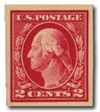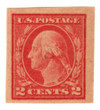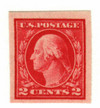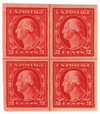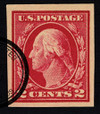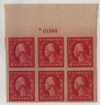
1916-17 2c Washington, carmine, imperforate, type I
# 482 - 1916-17 2c Washington, carmine, imperforate, type I
$1.50 - $35.00
U.S. #482
Series of 1916-17 2¢ Washington
Type I
Series of 1916-17 2¢ Washington
Type I
Issue Date: December 8, 1916
Printed by: Bureau of Engraving and Printing
Printing Method: Flat plate
Watermark: None
Perforation: None
Color: Carmine
Printed by: Bureau of Engraving and Printing
Printing Method: Flat plate
Watermark: None
Perforation: None
Color: Carmine
In 1916, the Postal Service issued the last of the flat plate imperforate stamps, and the first to be printed on unwatermarked paper. The Series of 1916-17 2¢ Imperforate Washington was printed using only a Type I die.
The 2¢ Washington Type I stamp has several distinguishing features: a pronounced white line underneath Washington’s ear, and the bottom two strands of hair behind his ear are shorter than the ones above it. Other features are often less distinct than found on Type II or Type III dies.
Mail During World War I
Because soldiers didn’t have free franking privileges at the start of the war, the U.S. Post Office issued booklet panes of 1¢ and 2¢ stamps specifically for the American troops in France. When the Act of October 1918 granted that military personnel could send mail free of postage, the booklets were no longer necessary and were returned to the United States.
In addition to the Post Office Department, service organizations such as the Red Cross, YMCA, and the Salvation Army provided our troops with a variety of postal cards. Soldiers were issued cards for Christmas and Easter, as well as special cards which were used when troops embarked on their voyage to France, or when a soldier changed camps.
These cards carried messages such as “The ship on which I sailed has arrived safely overseas.” or “Hello. Am feeling great. Will write again soon. Am going to camp...” and had blanks for pertinent information and the sender’s name. Blank postcards were also provided for short messages home.
Field service cards were another form of stationery issued to the troops. Produced by the American Expeditionary Forces (AEF), these postcards had pre-printed messages that could be filled out by the soldier without giving away important military information. Some cards had various sentences printed on them which the men could simply cross out if they did not apply, while other cards left blanks for the soldier to fill in regarding where he was stationed and his state of health.
Perhaps one of the most sought-after pieces of wartime postal items is the Christmas coupon. According to general orders, each man was given one coupon and an envelope. This coupon, after being endorsed by an officer, could then be sent to the soldier’s family or anyone stateside from whom he was expecting a package. Using this coupon, packages could be sent at a special rate of fifteen cents. The packages were restricted in size and could not exceed 3 pounds.
In 1989, Mystic Stamp Company Vice President David Sundman presented the Smithsonian Institution with a 2¢ AEF Booklet Pane. This unique piece of postal history is now a permanent part of the National Philatelic Collection that is housed in the Smithsonian’s National Postal Museum.
U.S. #482
Series of 1916-17 2¢ Washington
Type I
Series of 1916-17 2¢ Washington
Type I
Issue Date: December 8, 1916
Printed by: Bureau of Engraving and Printing
Printing Method: Flat plate
Watermark: None
Perforation: None
Color: Carmine
Printed by: Bureau of Engraving and Printing
Printing Method: Flat plate
Watermark: None
Perforation: None
Color: Carmine
In 1916, the Postal Service issued the last of the flat plate imperforate stamps, and the first to be printed on unwatermarked paper. The Series of 1916-17 2¢ Imperforate Washington was printed using only a Type I die.
The 2¢ Washington Type I stamp has several distinguishing features: a pronounced white line underneath Washington’s ear, and the bottom two strands of hair behind his ear are shorter than the ones above it. Other features are often less distinct than found on Type II or Type III dies.
Mail During World War I
Because soldiers didn’t have free franking privileges at the start of the war, the U.S. Post Office issued booklet panes of 1¢ and 2¢ stamps specifically for the American troops in France. When the Act of October 1918 granted that military personnel could send mail free of postage, the booklets were no longer necessary and were returned to the United States.
In addition to the Post Office Department, service organizations such as the Red Cross, YMCA, and the Salvation Army provided our troops with a variety of postal cards. Soldiers were issued cards for Christmas and Easter, as well as special cards which were used when troops embarked on their voyage to France, or when a soldier changed camps.
These cards carried messages such as “The ship on which I sailed has arrived safely overseas.” or “Hello. Am feeling great. Will write again soon. Am going to camp...” and had blanks for pertinent information and the sender’s name. Blank postcards were also provided for short messages home.
Field service cards were another form of stationery issued to the troops. Produced by the American Expeditionary Forces (AEF), these postcards had pre-printed messages that could be filled out by the soldier without giving away important military information. Some cards had various sentences printed on them which the men could simply cross out if they did not apply, while other cards left blanks for the soldier to fill in regarding where he was stationed and his state of health.
Perhaps one of the most sought-after pieces of wartime postal items is the Christmas coupon. According to general orders, each man was given one coupon and an envelope. This coupon, after being endorsed by an officer, could then be sent to the soldier’s family or anyone stateside from whom he was expecting a package. Using this coupon, packages could be sent at a special rate of fifteen cents. The packages were restricted in size and could not exceed 3 pounds.
In 1989, Mystic Stamp Company Vice President David Sundman presented the Smithsonian Institution with a 2¢ AEF Booklet Pane. This unique piece of postal history is now a permanent part of the National Philatelic Collection that is housed in the Smithsonian’s National Postal Museum.




